1. Lee JG, Park MS, Jeong SJ, Kim SY, Na S, Kim J, et al. Critical care before lung transplantation. Acute Crit Care. 2018; 33(4):197–205. PMID:
31723886.
3. Yeo HJ, Yoon SH, Lee SE, Jeon D, Kim YS, Cho WH, et al. Current status and future of lung donation in Korea. J Korean Med Sci. 2017; 32(12):1953–1958. PMID:
29115076.

4. Egan TM, Murray S, Bustami RT, Shearon TH, McCullough KP, Edwards LB, et al. Development of the new lung allocation system in the United States. Am J Transplant. 2006; 6(5 Pt 2):1212–1227. PMID:
16613597.

5. Yeung JC, Keshavjee S. Overview of clinical lung transplantation. Cold Spring Harb Perspect Med. 2014; 4(1):a015628. PMID:
24384816.

6. Kotloff RM, Thabut G. Lung transplantation. Am J Respir Crit Care Med. 2011; 184(2):159–171. PMID:
21471083.

7. Ladin K, Hanto DW. Rationing lung transplants--procedural fairness in allocation and appeals. N Engl J Med. 2013; 369(7):599–601. PMID:
23883330.

8. Benvenuto LJ, Arcasoy SM. The new allocation era and policy. J Thorac Dis. 2021; 13(11):6504–6513. PMID:
34992830.
9. Yu WS, Kim SY, Kim YT, Lee HJ, Park S, Choi SM, et al. Characteristics of lung allocation and outcomes of lung transplant according to the Korean urgency status. Yonsei Med J. 2019; 60(10):992–997. PMID:
31538435.
10. Yeo HJ, Kim DH, Kim YS, Jeon D, Cho WH. Performance changes following the revision of organ allocation system of lung transplant: analysis of Korean Network for Organ Sharing data. J Korean Med Sci. 2021; 36(12):e79. PMID:
33783144.
11. Keeshan BC, Rossano JW, Beck N, Hammond R, Kreindler J, Spray TL, et al. Lung transplant waitlist mortality: height as a predictor of poor outcomes. Pediatr Transplant. 2015; 19(3):294–300. PMID:
25406495.
12. Kourliouros A, Hogg R, Mehew J, Al-Aloul M, Carby M, Lordan JL, et al. Patient outcomes from time of listing for lung transplantation in the UK: are there disease-specific differences? Thorax. 2019; 74(1):60–68. PMID:
30282722.
13. Hirama T, Akiba M, Watanabe T, Watanabe Y, Notsuda H, Oishi H, et al. Waiting time and mortality rate on lung transplant candidates in Japan: a single-center retrospective cohort study. BMC Pulm Med. 2021; 21(1):390. PMID:
34844592.

14. Nie JB, Jones DG. Confucianism and organ donation: moral duties from xiao (filial piety) to ren (humaneness). Med Health Care Philos. 2019; 22(4):583–591. PMID:
30903406.

15. Antoine C. Organ allocation system: between efficiency and equity. Rev Prat. 2007; 57(3):262–268. PMID:
17578026.
16. Ainge-Allen HW, Glanville AR. Timing it right: the challenge of recipient selection for lung transplantation. Ann Transl Med. 2020; 8(6):408. PMID:
32355852.

17. Christie JD, Edwards LB, Kucheryavaya AY, Aurora P, Dobbels F, Kirk R, et al. The registry of the International Society for Heart and Lung Transplantation: twenty-seventh official adult lung and heart-lung transplant report--2010. J Heart Lung Transplant. 2010; 29(10):1104–1118. PMID:
20870165.
19. Valapour M, Lehr CJ, Skeans MA, Smith JM, Miller E, Goff R, et al. OPTN/SRTR 2019 annual data report: lung. Am J Transplant. 2021; 21(Suppl 2):441–520. PMID:
33595190.
20. Lee SH, Yeo Y, Kim TH, Lee HL, Lee JH, Park YB, et al. Korean guidelines for diagnosis and management of interstitial lung diseases: part 2. idiopathic pulmonary fibrosis. Tuberc Respir Dis. 2019; 82(2):102–117.
21. Jegal Y, Park JS, Kim SY, Yoo H, Jeong SH, Song JW, et al. Clinical features, diagnosis, management, and outcomes of idiopathic pulmonary fibrosis in Korea: analysis of the Korea IPF Cohort (KICO) registry. Tuberc Respir Dis. 2022; 85(2):185–194.
22. Rhee CK. It is time to consider human leukocyte antigen compatibility in lung transplantation. J Korean Med Sci. 2022; 37(22):e187. PMID:
35668691.
23. Kim HE, Yang YH, Paik HC, Jeong SJ, Kim SY, Park MS, et al. The assessment and outcomes of crossmatching in lung transplantation in Korean patients. J Korean Med Sci. 2022; 37(22):e177. PMID:
35668687.


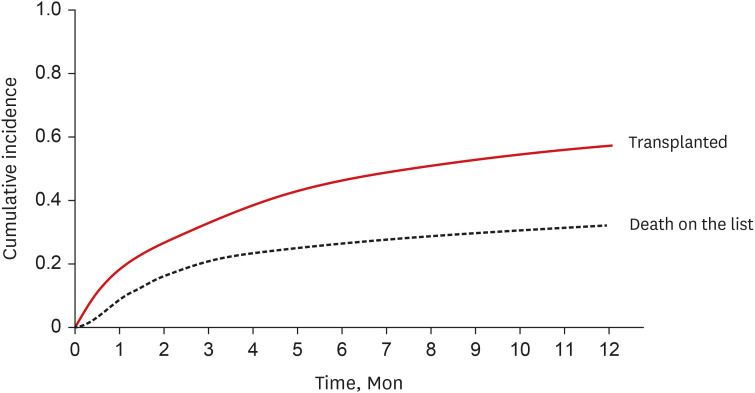

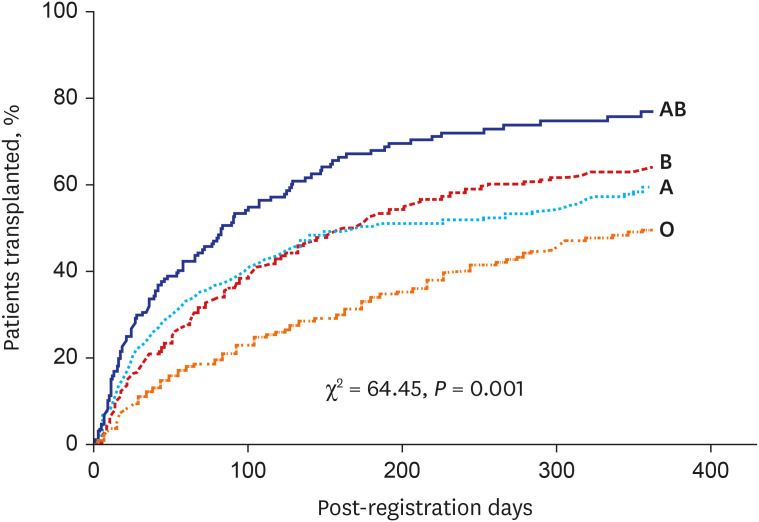

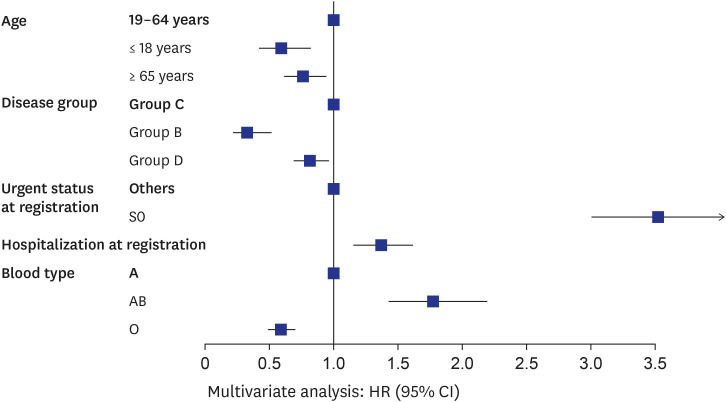
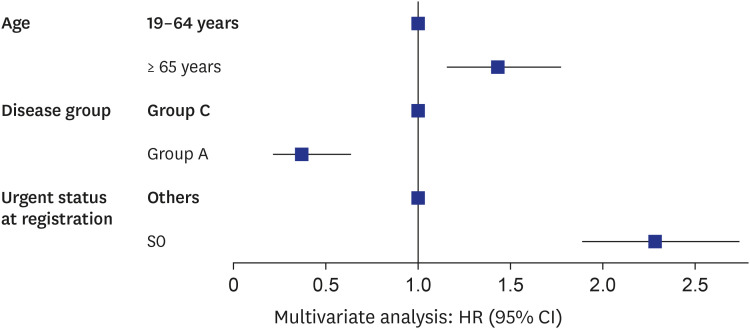




 PDF
PDF Citation
Citation Print
Print



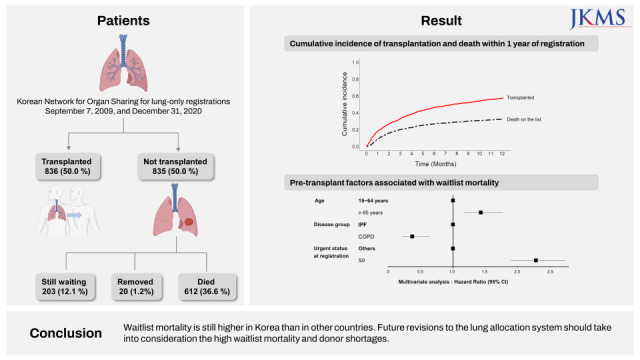
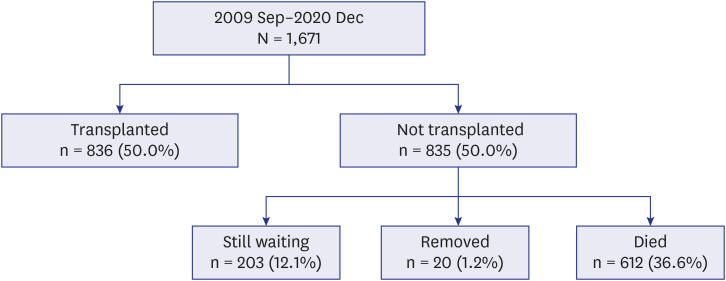
 XML Download
XML Download